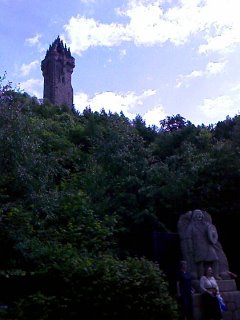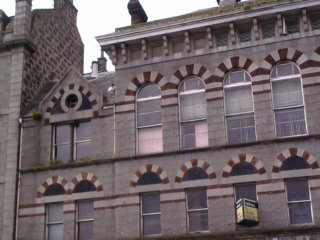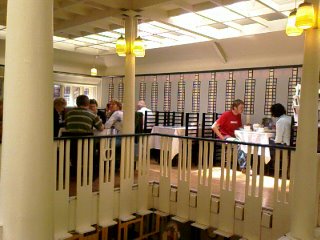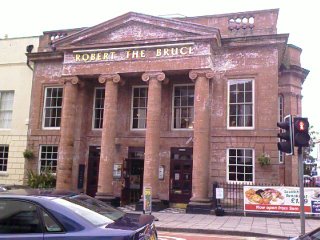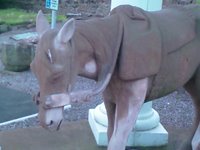
The usual morning changeover of clientele has occurred at the hostel. Jean and Heather have packed their car and left, and I've moved back into the four-bunk room I originally reserved. Geoff has also gone, which I feel a little sad about; I enjoyed his company and was looking forward to talking with him more over meals at the hostel.
 I took off from the hostel myself at 10am to overcast skies and the threat of rain--the first I've had in weeks. My aim is the Watchtower, that little square blob on the hill in the photo.
I took off from the hostel myself at 10am to overcast skies and the threat of rain--the first I've had in weeks. My aim is the Watchtower, that little square blob on the hill in the photo.
 It's accessible through a forest trail that starts at the castle parking lot (blue route) and passes by several long-ago-imported, but very familiar to me from Whimsor's backyard, towering Western Red Cedars. Next to the largest, there's a signpost on which someone has scribbled "BIG!! TREE..." Well, yeah.
It's accessible through a forest trail that starts at the castle parking lot (blue route) and passes by several long-ago-imported, but very familiar to me from Whimsor's backyard, towering Western Red Cedars. Next to the largest, there's a signpost on which someone has scribbled "BIG!! TREE..." Well, yeah. The walk travels past an old lime kiln and processing house (no roof, overgrown inside), the foundation remains of military activity (this land was a munitions base in the war), and a derelict "beehive" house (a round stone building with broken timbers, debris-strewn interior, and a collapsing conical roof that in better days would be reminiscent of Hagrid's home).
The walk travels past an old lime kiln and processing house (no roof, overgrown inside), the foundation remains of military activity (this land was a munitions base in the war), and a derelict "beehive" house (a round stone building with broken timbers, debris-strewn interior, and a collapsing conical roof that in better days would be reminiscent of Hagrid's home).Rain pattered through the trees, so I stopped long enough to pull on rain pants and jacket. Good thing, as the water started coming down in earnest afterward.
The trail is mapped on a brochure (which I quickly found out was not waterproof) and pretty well numbered with signposts. But I couldn't find post #16. I continued to follow a trail of bootprints past #15, but after slopping through a quarter mile of slick mud, slapping wet tree branches, waist-high sopping fern, and rivulets of water running down the hillside, I figured I was on the wrong track: I was staying level and spiraling around the hill instead of going up. I was also beginning to lament my decision to leave my trekking poles at the hostel and began sampling a large array of muddy fallen branches to use instead.
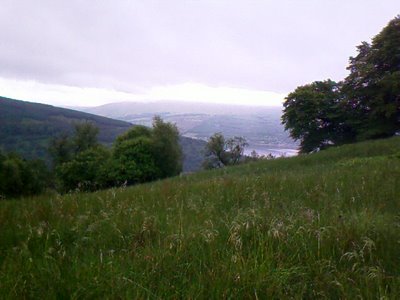 I doubled back and was soon huffing and puffing my way up the steepest part of the ascent--a stony track alongside a brook. The rain had lightened up, and I pulled into a clearing to a stupendous view of Loch Fyne and Inveraray...and I wasn't even at the top of the hill yet.
I doubled back and was soon huffing and puffing my way up the steepest part of the ascent--a stony track alongside a brook. The rain had lightened up, and I pulled into a clearing to a stupendous view of Loch Fyne and Inveraray...and I wasn't even at the top of the hill yet.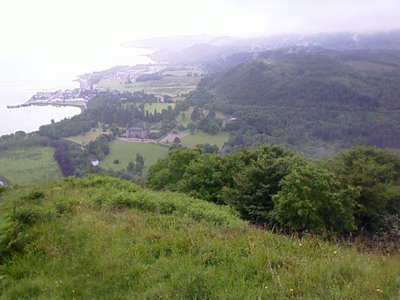

 I reached it at 12:15, and what a reward for the effort: a 360 view of Loch Fyne to the east, Inveraray Castle and town to the south, and hills on the Argyll peninsula at the west and north. The rain had almost stopped, and mists were coming in over the land and water.
I reached it at 12:15, and what a reward for the effort: a 360 view of Loch Fyne to the east, Inveraray Castle and town to the south, and hills on the Argyll peninsula at the west and north. The rain had almost stopped, and mists were coming in over the land and water.
 The 1740s tower itself is far less interesting than the broken down beehive house--blockish with a few simple tiers of stone at the top, like a square wedding cake. I took shelter from the wind inside with a lunch of salami, cheese, tea, apple, shortbread, and Hula Hoops chips. Hula Hoops have become my favorite crisps for travel--they taste like Pringles, are shaped like finger rings, and don't crush into bitty bits while riding in a daypack.
The 1740s tower itself is far less interesting than the broken down beehive house--blockish with a few simple tiers of stone at the top, like a square wedding cake. I took shelter from the wind inside with a lunch of salami, cheese, tea, apple, shortbread, and Hula Hoops chips. Hula Hoops have become my favorite crisps for travel--they taste like Pringles, are shaped like finger rings, and don't crush into bitty bits while riding in a daypack.
 I hung around the top of the hill for an hour, then took the quick trail down, over the gravel vehicle road at the back of the hill. The trip up would have been so much faster had I taken that road, but far less interesting. The bridge over the river Aray had some interesting old graffiti, some of it looking like it had been carved by someone who knew how to do it. Had tea and hot soup at the Inveraray Castle tea room.
I hung around the top of the hill for an hour, then took the quick trail down, over the gravel vehicle road at the back of the hill. The trip up would have been so much faster had I taken that road, but far less interesting. The bridge over the river Aray had some interesting old graffiti, some of it looking like it had been carved by someone who knew how to do it. Had tea and hot soup at the Inveraray Castle tea room.I came back from the hike to meet a new guest at the hostel tonight: Ani, a Tibetan Buddhist nun who told me a lot about Jura, one of the islands that Geoff had talked up. She was on her way to Glasgow to pick up her granddaughter, who has just graduated from University outside London and is joining Ani for a visit on Jura.
I liked Ani immediately, and by the time we spent an hour together, I was convinced that I needed to change my plans and spend several days on Jura. It's a remote place in the Scottish Hebrides. Ani describes it as an island with only 200 residents, where the red deer outnumber the people thirty to one, and the phone directory is one A4 page printed on both sides.
I broke out my local maps and brochures, we spread them out, and she described how I'm to get there--an hour bus from Inveraray, a two-hour ferry to Islay (EYE la), and a five-minute ferry to Jura, where a bus can meet the boat to take me to Craighouse, the only village on the island. ("Gwen The Bus Driver will tell you all the island stories on the way to Craighouse.")
I went to bed that night excited over my decision. This side trip to Jura is another one of those "I'm not sure why I'm doing this but I'm supposed to" excursions. The trick will be to reschedule the week I'm to spend WWOOFing in Torlundy for one week later, to arrange all the appropriate bus and ferry tickets to and from, and to find affordable lodging on the island for five nights in a row.
And here I'd had discarded a visit to an island because I thought it would be too much trouble to arrange.



